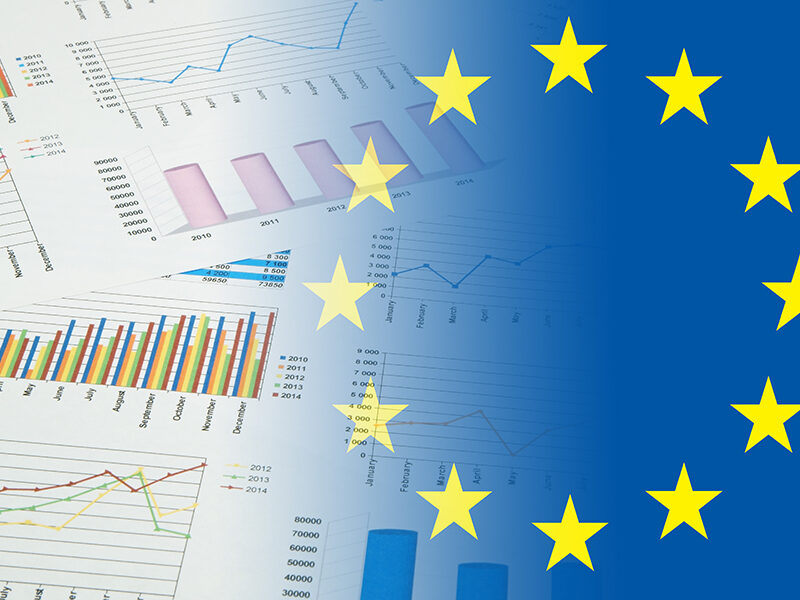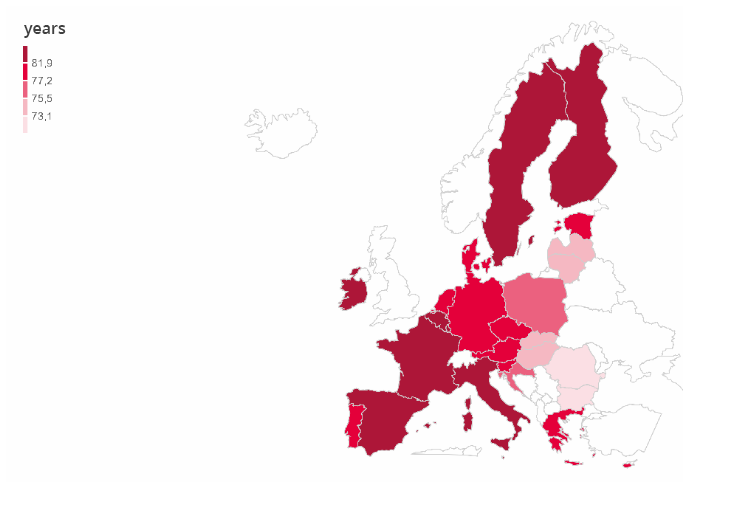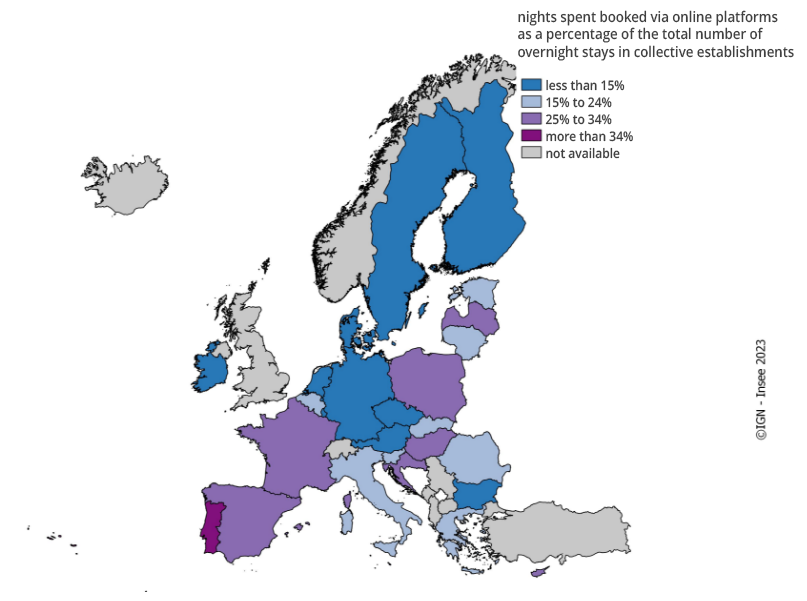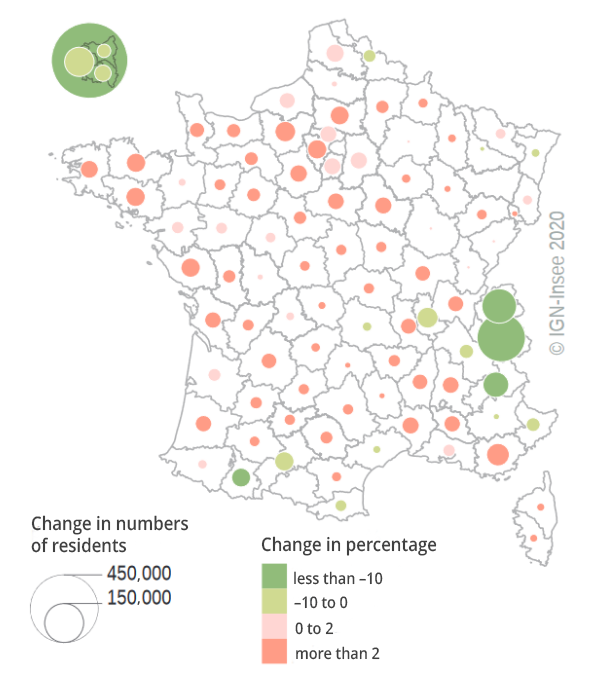
Thanks to the European Union, More Data for Public Decision-Makers
Insee publishes statistics on France and regularly provides analyses comparing the French economy and society with those of other European countries. But who publishes statistics on Europe? Eurostat, the European statistical office , a directorate-general of the European Commission, acts as an aggregator: it collects and compiles data from various member states. It also plays a coordinating role to harmonize and make data comparable; under Eurostat’s guidance, countries work together to establish common definitions and concepts. Following the Greek public debt crisis, Eurostat’s role as a guarantor of data quality has been strengthened. Moreover, in recent years, with the emergence of new data sources, Eurostat can play a central role when data access makes more sense at the European level than at the national level. This is particularly true for statistics on cross-border employment dynamics or tourism flows.
More broadly, Europe offers opportunities for mobilizing new information sources by becoming the single point of contact for data providers across European countries. The recently revised European statistical law (Regulation 223/2009) will facilitate access to data sources from private operators for the production of national and European statistics. Two examples include the use of private data from tourism platforms and mobile phone operators. This opens new horizons for producing statistics harmonized at the European level.
Two-thirds of the statistics produced by Insee are developed within a European framework, ensuring the ability to calculate these statistics at the European level and compare European countries with each other (Lagarde, 2022). For instance, life expectancy at birth in 2021 averaged 80.1 years across the 27 European Union countries; in France, it was 82.4 years, more than two years above the average. (figure 1).
Figure 1 – Life expectancy at birth in the European Union in 2021

Outil interactif : Tableau de bord de l’économie française/Démographie/Décès, mortalité, espérance de vie
The European Statistical System (ESS), comprising Eurostat, national statistical institutes, and certain services producing European statistics in each member state, provides comparable statistics across the European Union (Insee, 2024). These data are used to monitor European policies on social, economic, and territorial cohesion, sustainable development, agricultural policy, and globalization.
Harmonized Statistics Among EU Member States
For effective governance of the European Union and evidence-based decision-making, it’s essential to rely on internationally defined and tested concepts (e.g., unemployment as defined by the International Labour Organization, consumer price index), shared classifications (European economic activity nomenclature, educational attainment levels), and common conceptual frameworks (European national accounts manuals). The production and dissemination of European statistics are governed, in each domain, by statistical regulations aimed at harmonizing data produced by national statistical services of member states. These regulations result from technical collaboration among European countries to establish shared concepts, benefiting from each country’s expertise. To give an example, Insee is currently participating in a working group preparing a future regulation aimed at producing comparable European statistics on commercial property prices.
This obligation to produce statistics that comply with the definitions and conceptual frameworks adopted in European statistical regulations is known as output harmonisation. When the need for comparability is very strong, harmonisation can also apply to the method of data collection, for example by using a questionnaire that is common to all countries. This is the case in particular for the part of the Labour Force Survey used to measure the unemployment rate according to the ILO definition. This is known as input harmonisation.
In addition to harmonizing definitions and, at times, measurement methods, the quality of European statistics is also ensured by a specific framework akin to certification. The entire European Statistical System (ESS), under Eurostat’s guidance, verifies compliance by statistical institutes with the European Statistics Code of Practice. This code, adopted by the European Statistical System Committee, ensures the independence, integrity, and accountability of national and community statistical services. It comprises 16 principles in its latest version updated in 2017: 7 principles related to the institutional environment, 4 to statistical production processes, and 5 to statistical outputs. The implementation of the common quality framework, and thus the quality of European statistics, is notably ensured through a peer review mechanism within the ESS, the latest of which was conducted in 2021 for France.
Europe Facilitates the Use of New Data Sources
Beyond ensuring the comparability of statistics and guaranteeing quality and independence in statistical production, Europe opens opportunities for new data sources and innovation. This enriches statistical data on topics that are challenging to cover through surveys. This is evident in three projects utilizing private data from tourism platforms (Collaborative Economy Platforms project) or mobile phone operators (MNO-MINDS: « Smart and Trustworthy Statistics: Methodological Developments Based on New Data Sources » and Multi-MNO: « Development, Implementation, and Demonstration of a Reference Processing Pipeline for the Future Production of Official Statistics Based on Data from Multiple Mobile Network Operators »).
The Contribution of Vacation Rental Data from Collaborative Platforms
In tourism, the short-term vacation rental segment is traditionally underrepresented in conventional surveys: data on holiday homes, apartments, and rooms in private buildings often fall outside the scope of existing tourism occupancy surveys. The multitude of market players makes data collection more challenging. In March 2020, Eurostat reached a historic agreement with Airbnb, Booking, Expedia Group, and TripAdvisor on data sharing. This agreement allows Eurostat to be the single point of contact for these groups across all countries, thereby obtaining key data on short-term accommodation rentals from the four collaborative platforms. Collecting data from these platforms improves the quality of European tourism statistics by providing a more comprehensive observation field.
The data obtained from the platforms cover short-term accommodations (excluding hotels and campsites, which are traditionally surveyed) booked through these four collaborative economy platforms within the European Union (EU) and the European Free Trade Association (EFTA) countries. To preserve confidentiality, data from the four platforms are aggregated. Eurostat conducts analyses based on these data, such as the evolution of the number of nights booked via these platforms between 2019 and 2022.
Insee utilized these data as early as 2021 for an analysis of the year 2019 (Ulrich, 2021). It emerged that, among European cities in terms of peer-to-peer rentals, Paris ranks first, ahead of Barcelona, Lisbon, and Rome. Like most capital cities, it is popular year-round with an international clientele. With over 5 million overnight stays, Nice ranks ninth and rivals cities such as Porto and Vienna. These data have been contributing since 2023 to the publication L’Essentiel… sur le Tourisme. By leveraging this unique data source, France stands out as a preferred destination for this type of booking and accommodation, accounting for one-quarter of all short-term rental overnight stays in the European Union in 2022. A notable French characteristic is the high proportion of residents among those using such accommodations — significantly higher than in Spain or Italy, which are more reliant on international visitors. Furthermore, overnight stays in short-term rentals via platforms represented 30% of total nights spent in collective accommodations (see Figure 2). That share is lower than in Portugal (43%), but higher than in Spain (26%) or Italy (20%).
Figure 2 – Number of nights spent in short-stay accommodation booked via online platforms as a percentage of the total number of overnight stays in collective establishments (hotels, campsites, and other tourist accommodations)

Reading note: in France, in 2022, nights spent in short-stay accommodation booked via online platforms accounted for between 24% and 35% of all nights spent in collective accommodation establishments.
Scope: European Union (27 countries); accommodations offered by private individuals via major international platforms; survey on attendance in collective tourist accommodation establishments.
Source: Eurostat.
Valuable Mobile Phone Data for Understanding Presence and Mobility
Mobile phone data have long been identified as a promising source for enhancing the relevance of official statistics. Their primary advantage lies in the ability to analyse the population present in a given area at different times of the day, different days of the week, or months of the year—information that is crucial for services such as health care, public safety, and retail (Semecurbe et al., 2020). Mobile phone data can also provide complementary insights into daily mobility patterns. The origin-destination trajectories of mobile phone users help to better understand interactions between territories, differences in behaviour between weekdays and weekends, the impact of remote work on mobility practices, or the movement patterns of retirees and parents of young children (see Figure 3). These data, available at a high temporal frequency and across the entire national territory, serve as a valuable complement to traditional reference data obtained through public statistical surveys or administrative registers.
Figure 3 – Change in the number of mainland residents present in the department during the first lockdown

Note: changes involving fewer than 1,000 people are not shown.
Interpretation: during the lockdown, in addition to the departure of foreign visitors and residents from the French overseas departments, Paris saw its present population decrease by 450,000 people (a 20% drop). This population decline was due to non-residents of the capital returning home and Parisians leaving the city.
Scope: reference period outside lockdown from January 16 to the morning of March 17, 2020; lockdown period from the evening of March 17, 2020 to the morning of May 11, 2020.
Sources: Bouygues Telecom, Orange, SFR, mobile phone network activations; INSEE calculations.
Europe Plays a Major Role in Driving Innovation
Europe plays a major role in fostering innovation. On emerging issues of this kind, collaboration between multiple countries, organized and structured by Eurostat, enhances each country’s capacity for innovation. The Big Data 1 and Big Data 2 projects, conducted by Eurostat from 2017 to 2021, brought together around twenty European countries to jointly develop common tools for processing new data sources, including mobile phone data. Eurostat was also involved in a research partnership between the sociology research lab of the telecom operator Orange and Insee. This partnership led to several studies highlighting both the value of mobile phone data for official statistics and the related methodological challenges (Sakarovitch et al., 2018). In September 2023, the members of the working group on the use of mobile phone data for official statistics, coordinated by Eurostat, co-signed an article advocating for the development of a common methodology to produce official statistics based on mobile phone data (Eurostat, 2023).
Eurostat continues to initiate and coordinate innovative projects related to mobile phone data. The MNO-MINDS research project (2023–2025) brings together ten national statistical institutes (NSIs) to develop a common methodological framework for combining mobile phone data with other data sources (data collected by the NSIs and data from other sources: road traffic sensors, public transport ticketing systems, etc.). On the same timeline, the multi-MNO project involves statistical institutes and mobile network operators from several countries (Spain, Italy, Slovenia, Luxembourg). The objective is to develop a reference technical process that enables the integration of data from different operators, while respecting the confidentiality of personal data. Insee is heavily involved in these efforts, acting as the leader of a working group within the MNO-MINDS project and as a member of the advisory board of the multi-MNO project.
Facilitating the Use of Private Data for Statistical Purposes
These two examples illustrate a new trend marked by the use of data held by private actors. The digital transformation of society has led to the emergence of numerous data sources, characterized by large volumes (data from the internet, sensors), diverse formats (images, texts), and high-frequency flows. User expectations have also evolved, with new needs and increasing demand for more detailed information, with finer geographical resolution, produced more rapidly and at higher frequency. Alongside traditional data sources (surveys and administrative records), the exploitation of new private sources by statisticians makes it possible to meet these new needs effectively (Dupont, 2023).
Facilitating the use of private data for statistical purposes is the main objective of the revision of Regulation 223/2009, the “European Statistical Law,” which sets the legal framework for the development, production, and dissemination of European statistics. Following a 2015 revision that strengthened the governance and independence of the European statistical system, the 2024 revision aims to facilitate access to data sources from private operators for the production of European statistics.
Admittedly, Insee already uses private data for statistical production, such as the consumer price index (Leclair, 2019). However, the national statistical law (Article 3bis of the 1951 law) limits the mandatory transmission of private data to cases where such data substitute for an existing survey. This restriction is not present in the revised Regulation 223, thus opening new opportunities for the use of private data in the production of European statistics. The new regulation effectively removes the main obstacles identified by statisticians in using private data for statistical production of European statistics: it provides a solid legal framework that can be enforced against private data holders so that data transmission is sustainable and of high quality, while ensuring the confidentiality of individual data used by statisticians.
The revised Regulation 223/2009 thus opens new horizons for the production of statistics harmonized at the European level. It also addresses other topics such as data exchanges between European national statistical institutes, and the management of statistical operations during a crisis period. Experimental projects, such as those previously mentioned concerning mobile phone data, can therefore be conducted more regularly and with a consistent methodology across Europe. ■
To learn more
- European Commission, 2016, Communication from the Commission to the European Parliament, the Council, the European Economic and Social Committee and the Committee of the Regions – A European agenda for the collaborative economy, June
- Coudin É., de Bellefon M-P., Galiana L., Semecurbe F., Suarez Castillo M., 2020, « Partial return of population movements after lockdown », Insee Analyses, July
- Coudin É., Galiana L., Poulhes M., Semecurbe F., Suarez Castillo M., 2020, «
What can Insee do with mobile phone data? », Le blog de l’Insee, April - de Bellefon M.-P., Givord P. , Sakarovitch B., Vanhoof M., 2019, «
Estimating the resident population using mobile phone data », Économie et Statistique / Economics and Statistics n° 505-506 – 2018, 109–132, April - Dupont F., 2023, « What types of sources does Insee use to build its statistics? », Le blog de l’Insee, May
- ESS Task Force on the use of Mobile Network Operator (MNO) data for Official Statistics, 2023, « Reusing mobile network operator data for official statistics: the case for a common methodological framework for the European Statistical System – 2023 edition » Eurostat position paper, September
- Insee, 2024, France in the European Union – Data and Studies, March
- Insee, 2023, Trusted Smart Statistics: methodological developments based on new data sources, October
- Lagarde S., 2022, « For statisticians, Europe is part of daily life », Le blog de l’Insee, January
- Ulrich. A., 2021, « Paris and Nice among the top 10 most visited EU cities in 2019 », Insee Première n° 1879, November
- Leclair M., 2019, « Using checkout data to calculate the consumer price index », Courrier des statistiques, December
- Parlement européen et Conseil de l’Union européenne, 2009, Revised Regulation (EC) No 223/2009 on European statistics, March
Credits: © Valerii Evlakhov – stock.adobe.com





